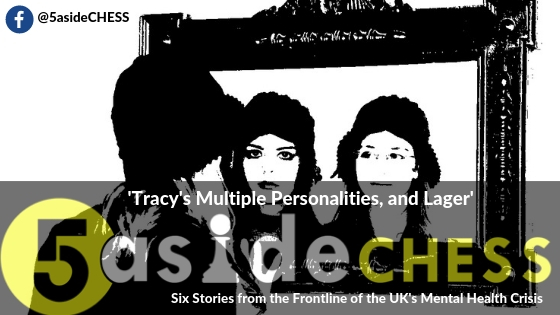As the Military Tattoo fireworks crashed up into the sky, Tracy threw the last chair out of the window. She hadn’t taken the diagnoses well. And, while Edinburgh cheered and flashed colour, she sat drunk and crying. Her landlord kicked her out.
“That was the last straw,” she said, still boozy in the morning. “I was doing ok but the diagnosis did me in.”
Tracy was diagnosed with Dissociative Identity Disorder (DID), which is formerly and more commonly known as Multiple Personality Disorder.
Essentially, it means different personalities or identities take the reins of a person at different times. Around 70 percent of people with DID attempt suicide.
Confusion in the NHS
“The doctor didn’t need to do it. If it was one of his friends, I tell ya, he would of stuck with the borderline (Borderline Personality Disorder). Now I have to wait for a new care package with the NHS.”
Confusion and lager is a twisted breakfast mix.
NHS England reports that the wait for ‘key interventions’ for people with ‘severe mental health problems’ is “Very Long.” And that one quarter of the people using ‘secondary mental health services’, like Tracy, do not even know who is coordinating there care.
The confusion percentage is high in this part of the healthcare system, while three quarters of people with mental health issues in the UK recieve no care at all.(pg8)
Tracy’s diagnosis, essentially, was that more than one personality was at work within her mind. These personalities can have different memories, ages, attitudes and behaviours. Emma Young has written a brilliant piece about DID for Mosiac.
Multiple Personalities and Alone
“It means I can’t get the therapy now,” Tracy said. “I have to wait for a new one for this new condition, and they can’t even tell me how long it’ll take. Look,” she said. “I won’t waste no more of your time. I just saw the bus and, yeah, don’t. Sorry for wastin’ your time.”
“I’m literally not doing anything. Sit down if you want.”
Tracy was beat up and bloated. She smelt sharp. Her big and vulnerable eyes squinted through a film of glassy booze. Her dog dragged its nose along the floor.
“I can’t play chess,” she said.
“I can’t really either,” I said.
She laughed and played for a bit and seemed to relax.
“I was having therapy for my borderline then this all started. It’s bad darlin’, now, I don’t know what to do.”
She looked up from the board and took a glug of beer.
“I’ve been hypnotised. The lot. Wooooo. Look into my eyes.” Tracy spoke quickly.
She fidgeted and got up and kind of span in tight circles.
“I like the messages,” she said. “Sad though.”
“Who the fuck is supporting me though? No one, that’s who. No care, no support. Just a fucking diagnosis and a fuck you.”
Lack of Mental Health Practitioners
I hadn’t even noticed the Spanish waiters that morning. A woman dressed in green walked through the metal tables and came up to the bus.
Her air of normality seemed to embarrass Tracy.
“Sorry for wasting your time,” she said.
“I have cake,” the woman in green said.
Tracy limped off into a wilderness, her belly hanging out of a grey Motorhead T-shirt.
“Did I interrupt?”
“I’m not sure. She had a diagnosis that span her out I think.”
“I actually work in mental health,” she said. “I saw you guys playing chess with people and thought I’d stop by.”
“Nice cake.”
“I think diagnosis can be good and bad,” she said. “Mental health is so hard because it’s more specific than physical health.”
“More specific?”
“As in, the effects of treatment and diagnosis can be so unique to one person, based entirely on what their overall mental health is, that you need well-trained and experienced practitioners to know how to treat each person. And there aren’t enough of them.”
Emily’s story about the problems with funding tells its own story about the state of mental health care in the UK.
These Connections and the Battling Suicide Tour were made possible by Bright Hygiene. Follow 5asideCHESS and help us make a difference on Facebook, Instagram and Twitter !


